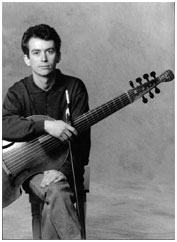Double the Gamba
 The Ionarts Baroque Weekend™ had already brought us to hear concerts by Tafelmusik, Ensemble Matheus, and the Orchestra of New Spain. The afterparty was hosted by La Maison Française on Monday night, with a concert by two viola da gambists, Jérôme Hantaï (pictured) and Kaori Uemura. In the walled-off corner of the French embassy's lobby, a damp cold crept through the windows after the embassy staff had turned off the noisy heating system. Soft light only on the musicians' podium, while not as evocative of the 17th century as candlelight à la Vincent Dumestre, provided an atmospheric envelope for this exploration of rarely heard music for two violas da gamba.
The Ionarts Baroque Weekend™ had already brought us to hear concerts by Tafelmusik, Ensemble Matheus, and the Orchestra of New Spain. The afterparty was hosted by La Maison Française on Monday night, with a concert by two viola da gambists, Jérôme Hantaï (pictured) and Kaori Uemura. In the walled-off corner of the French embassy's lobby, a damp cold crept through the windows after the embassy staff had turned off the noisy heating system. Soft light only on the musicians' podium, while not as evocative of the 17th century as candlelight à la Vincent Dumestre, provided an atmospheric envelope for this exploration of rarely heard music for two violas da gamba.
The program showed the wide popularity of the instrument in the 17th century by bringing together pieces from England, Germany, and France. The E minor sonata by August Kühnel (1645-1700) was a series of contrasting dance-like movements in the sonata da camera mode. It showcased the virtuosic technique of the two gamba players, as they traded accompanying and melodic figures in the fast movements and intertwined their lines like wrapping ivy in the gorgeous slow movement. The A minor suite by John Jenkins (1592-1678) opened with a mournful fantaisie, followed by an air answered by embellished divisions. In this piece, Hantaï seemed to drive the pace of the virtuosic sections just one notch too much for Uemura, who seemed to struggle slightly.
The first half ended with a delightful variation set, the Divisions in G by Christopher Simpson (1615-1669). The little chord progression that was the basis of this piece was harmonically simple but used a rhythmic trick, a hemiola pattern (3+3+2+2+2), to charming effect. The three Fantasies to the Organ by John Cooper (dit Coperario, 1575-1628) were pretty and calmly meditative, well suited for church use perhaps.Hantaï and Uemura:
Marin Marais
Couperin / Locke
More familiar composers were featured on the second half, which opened with the Pavane on a Theme by A. Ferrabosco by William Lawes (1602-1645). Organist Freddy Eichelberger, who gave elegantly rendered and embellished continuo accompaniment throughtout the concert, played the tune alone first. Lawes added viola da gamba parts essentially as bubbling rhythmic filler. Eichelberger finally opened up the louder stops of the portative organ for a solo performance on a chorale setting (Jesus Christus unser Heiland) by Dietrich Buxtehude. He gave consistent articulations to the the same composer's G major fugue, which helped bring out the contrapuntal voices.
Finally the concert was crowned with one of the masterpieces for this instrumental combination, the Suite in G from Marin Marais's first book published in 1686. The Allemande had a light character, almost in two instead of the usual, more deliberate four, and the Sarabande was luxuriant but not at all droopy, retaining the feel of a slow dance. After a spry Gigue, it was time for another of the sublime Marais chaconnes, the perfect bookend to one heard Friday night from Tafelmusik. More Marais was offered for the encore, a Gavotte en rondeau with a chirpy little tune as its happy refrain.
The next concert at La Maison Française will feature violist Roger Tapping on Leap Day (February 29, 7:30 pm). Although it is not an entirely Baroque program, Tapping will adapt Bach's G minor gamba sonata for the viola.





















































No comments:
Post a Comment